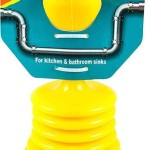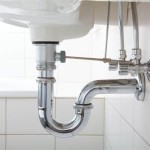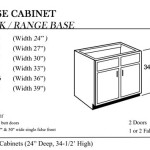```html
How To Replace A Sink Plug
Replacing a sink plug is a common household task that can often be completed without the need for a professional plumber. Over time, sink plugs can become damaged, worn, or simply lost, leading to inconvenience and potential water wastage. This article provides a comprehensive guide on how to replace a sink plug, covering various types of plugs and the necessary steps for effective installation.
Identifying the Type of Sink Plug
Before initiating the replacement process, it is crucial to identify the type of sink plug currently in use. Several common types exist, each with its own mechanism and replacement procedure. Recognizing the specific type will ensure the correct replacement part is purchased and the installation process is executed correctly.
1. Chain and Stopper: This is a traditional design where a rubber or metal stopper is attached to a chain. The chain is connected to a lever or ball rod located behind the faucet. Lifting the lever raises the stopper, allowing water to drain. To replace this type, typically only the stopper itself needs replacement.
2. Pop-Up Drain: Pop-up drains feature a stopper that is operated by a lift rod or lever located near the faucet. When the lever is lifted or lowered, it activates a mechanism that either lifts the stopper or seals the drain. Replacement of a pop-up drain plug often involves accessing the linkage beneath the sink.
3. Click-Clack Drain: Also known as a push-button drain, this type operates with a simple push-down mechanism. Pressing the stopper seals the drain, and pressing it again releases it. These are usually relatively simple to replace, often just requiring unscrewing the old plug and screwing in the new one.
4. Flip-Top Drain: Less common than the others, flip-top drains have a stopper that is flipped open or closed manually. These often involve a pivoting mechanism that can wear out over time. Replacing a flip-top drain may require disassembling the entire drain assembly.
Carefully examine the existing sink plug and its operating mechanism to accurately determine its type. This will streamline the replacement process and prevent the purchase of an incompatible replacement.
Gathering the Necessary Tools and Materials
Having the correct tools and materials on hand before starting the replacement is essential for a smooth and efficient process. This minimizes delays and prevents frustration during the installation. The specific tools required may vary depending on the type of sink plug being replaced, but the following list provides a general overview of commonly needed items.
1. New Sink Plug: Purchase a replacement plug that is compatible with the identified sink type and the size of the drain opening. Measure the diameter of the existing plug or drain opening to ensure a proper fit. Replacement plugs are available at most hardware stores and online retailers.
2. Adjustable Wrench: An adjustable wrench is necessary for loosening and tightening nuts and bolts that connect the drain assembly to the sink and plumbing. Having an adjustable wrench allows it to conform to the size of the nuts and bolts associated with the drain.
3. Basin Wrench (Optional): A basin wrench is specifically designed for accessing hard-to-reach nuts located behind the sink. This tool is particularly useful when working in tight spaces or when removing or installing the entire drain assembly.
4. Pliers: Pliers are useful for gripping and manipulating small parts, such as clips and linkages, during the replacement process. Needle-nose pliers can be especially helpful for accessing tight spaces.
5. Screwdriver: A screwdriver, either flathead or Phillips head, may be required for removing screws that hold the drain assembly together or for adjusting the lift rod mechanism. Determine the type of screws used in the existing assembly before starting.
6. Plumber's Putty: Plumber's putty is a pliable sealant used to create a watertight seal between the drain flange and the sink. This prevents leaks and ensures a secure connection. It is essential to use plumber's putty when replacing the entire drain assembly but not necessarily for just the plug itself.
7. Towel or Bucket: Place a towel or bucket beneath the sink to catch any water that may spill during the replacement process. This helps to prevent water damage and keeps the work area clean and dry.
8. Cleaning Supplies: Use cleaning supplies to clean the drain opening and surrounding area before installing the new sink plug. This removes any debris or buildup that could interfere with the new plug’s performance.
By gathering all the necessary tools and materials in advance, the replacement process can be completed more efficiently and with less risk of complications.
Step-by-Step Replacement Process
The process of replacing a sink plug will vary depending on the type of plug being replaced. The following steps provide a general guideline for replacing common types of sink plugs. Always refer to the manufacturer's instructions for specific guidance related to the replacement part being used.
1. Preparing the Work Area: Begin by turning off the water supply to the sink. This typically involves closing the shut-off valves located beneath the sink. Place a towel or bucket under the sink to catch any residual water. Clear away any items stored underneath the sink to provide ample workspace.
2. Removing the Old Sink Plug (Chain and Stopper): For a chain and stopper type, simply detach the old stopper from the chain by removing any clips or fasteners connecting them. The chain is usually connected to a lever behind the tap. If the chain is damaged, it can be replaced as well.
3. Removing the Old Sink Plug (Pop-Up Drain): Locate the lift rod or lever near the faucet. Unscrew the nut that connects the lift rod to the drain linkage beneath the sink. You may need pliers to loosen the nut. Disconnect the linkage from the drain stopper. The stopper may now be lifted out of the drain opening.
4. Removing the Old Sink Plug (Click-Clack Drain): These often simply unscrew. Rotate the top of the plug counter-clockwise to loosen and remove it. Some may have a small screw on the side that needs to be loosened first.
5. Removing the Old Sink Plug (Flip-Top Drain): These might require removing the entire drain assembly. If so, use a basin wrench or adjustable wrench to loosen the nut that secures the drain to the sink basin from underneath. Once the nut is loosened, carefully detach the drain assembly from the sink.
6. Cleaning the Drain Opening: Thoroughly clean the drain opening to remove any debris, buildup, or old plumber's putty. Use a scraper or brush to remove any stubborn residue. Ensure the surface is clean and dry before proceeding with the installation of the new sink plug.
7. Installing the New Sink Plug (Chain and Stopper): Attach the new stopper to the chain using the appropriate clips or fasteners. Ensure the connection is secure. Adjust the length of the chain so that the stopper seals the drain effectively when the lever is lowered.
8. Installing the New Sink Plug (Pop-Up Drain): Insert the new stopper into the drain opening. Connect the drain linkage to the stopper according to the manufacturer's instructions. Adjust the lift rod to ensure the stopper opens and closes properly. Tighten the nut that secures the lift rod to the drain linkage.
9. Installing the New Sink Plug (Click-Clack Drain): Simply screw the new plug into the drain opening. Ensure it's tightened securely. If there's a side screw to tighten, do so.
10. Installing the New Sink Plug (Flip-Top Drain): If the entire drain assembly was removed, apply a bead of plumber's putty around the underside of the drain flange where it will contact the sink. Position the drain assembly in the drain opening and secure it with the nut from underneath. Tighten the nut securely using the adjustable wrench or basin wrench. Remove any excess plumber's putty.
11. Testing for Leaks: Turn on the water supply to the sink and check for leaks around the drain opening and the drain assembly connections. If leaks are detected, tighten the connections further or reapply plumber's putty as needed. Ensure the sink plug seals the drain effectively when closed and opens smoothly when activated.
12. Final Adjustments: Make any final adjustments to the sink plug and drain linkage to ensure proper operation. Verify that the stopper seals tightly and releases easily. Clean up the work area and dispose of any waste materials appropriately.
Following these steps will enable a successful replacement of the sink plug. If complications arise or uncertainty persists, consulting with a professional plumber is always recommended.
Properly functioning sink plugs are essential for water conservation and preventing inconvenience. By understanding the different types of sink plugs and following the appropriate replacement procedures, homeowners can effectively maintain their plumbing systems and avoid costly repairs.
```
How To Replace A Rusty Sink Drain Howtolou Com

How To Replace A Sink Stopper Quick And Simple Home Repair

Bathroom Sink Drain Stopper Not Working

How To Replace Your Bathroom Sink Pop Up Assembly Plumbcraft Series With Penny

In My Sink Pop Up Stopper The Tip Of Pivot Rod Is Broken How Do I Fix It Home Improvement Stack Exchange

How To Remove A Sink Stopper The Home

Step By Guide On How To Install Sink Pop Up Drain Stopper

How To Remove A Sink Pop Up Stopper Hunker

3 Ways To Fix A Sink Stopper Wikihow

How To Remove A Sink Stopper The Home







